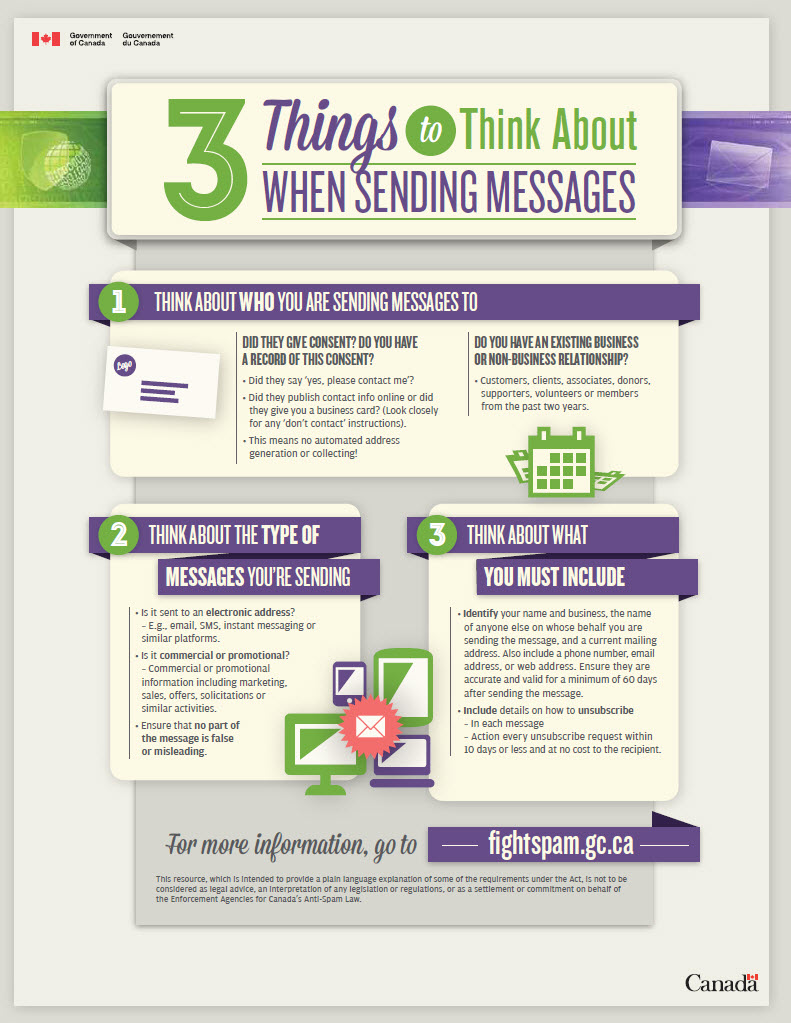Dollar for dollar, email newsletters provide one of the very best returns on marketing investment.
Although emails’ demise has been predicted for 20 years, it still stands that well-written, relevant bits of content, delivered directly (and ideally, regularly) to the inboxes of interested subscribers is a winning solution for businesses and nonprofits large and small. And the very best email delivery tools, such as Campaign Monitor (which we have used since its founding) and MailChimp, as well as their more powerful marketing automation cousins like Act-On, InfusionSoft, and Hubspot, offer digestible analytics to show how your content is being received.
Consent Means Kind of Interested
The important word here is interested. As you are probably aware, the Canadian government rolled out new legislation in July of 2014 that says to designers and marketers, in a nutshell, “Get Permission”. No longer can businesses in Canada simply send out email campaigns to unwitting individuals. And no longer could we assume that existing relationships imply consent. (Disclaimer: There are many additional teeth in the law. And by no means does this post mean to provide legal advice to you or your business.)
The legislation, called CASL, had few initial admirers here at Manoverboard. Our lovely list of over 500 human subscribers whose trust we had earned over the past 12 years could no longer be used. The law requires that we have clear consent from those subscribers to receive what the government calls “commercial electronic messages”.
But the law is the law. And, after studying CASL’s rules and parsing the government’s required and recommended practices, we put together a tight strategy for keeping as many of those 500 subscribers as we possibly could.

The Carrot and the Shtick
Our goal was to maintain 50% of our subscriber base. We got very close to that goal.
Here’s what we did and it’s what you might consider for your business over the next three years if you haven’t yet put together a strategy for keeping your subscribers.
First, we decided that there three staggered email blasts would be sent over the period of three weeks. We then set about writing the first email to subscribers which explained how we were complying with the law and that we were (but not too desperately) hoping that a subscriber would stick with us.
Insanely, this took about 8 hours.
(We also chose to sweeten the deal with an incentive: anyone who consented would be entered for a chance to win a subscription of Salt Spring Coffee, a sister B Corporation based in Vancouver.)
Next, we sent this email to all 552 subscribers. Within a few days, 267 people opened it (51%) and an astonishing 176 people (66%) clicked on a link. Of those 267 unique opens, 218 clicked on our consent link, which took readers to a thank you page on our site. With this email alone, we got a 40% consent rate.
About a week later, a second email was sent to anyone on our list who did not open the last newsletter. We changed the wording a little. This email went to 263 people, with 140 opens with 44 consenting to receive emails. That’s a 31% consent rate. Not too shabby.
One week later, a final email was sent to anyone who did not open the previous two. This resulted in 10 more consenting out of 39 unique opens — a consent rate of about 26%. You can see where this is going. The law of diminishing returns tells us that if a fourth email went out, we’d get a consent rate of about 18%. We did not bother.
CASL, Shmasl
In the end, our opt-in list is a decent size considering where we started - about 220 subscribers. (This number accounts for those who clicked multiple times, those who later unsubscribed, etc.)
We’re grateful to everyone who continued to stay with us. Lord knows, we all receive far too much email and our promise to our freshly squeezed list is, as always, to not be a pain and to provide helpful ideas and information.
Interestingly, we ran a similar campaign for a Canadian client with a much larger email list. Though their lists were cultivated differently, they achieved similar statistical results, proving that our strategy of multiple emails with straightforward messaging worked.
We stormed the CASL and saved nearly half our friends and followers. We can be assured that our subscribers are actually interested in our small business. Email marketing will survive another decade. In fact, it will be further refined through the application of marketing automation, guiding subscribers to their own success and becoming a more humane educational tool.
What is less clear is how the new Canadian law will influence a more aggressive, disruptive, and wily set of commercial electronic messages delivered through social media which, as a rule, has less respect for privacy, trust, and consent than traditional email marketing.

